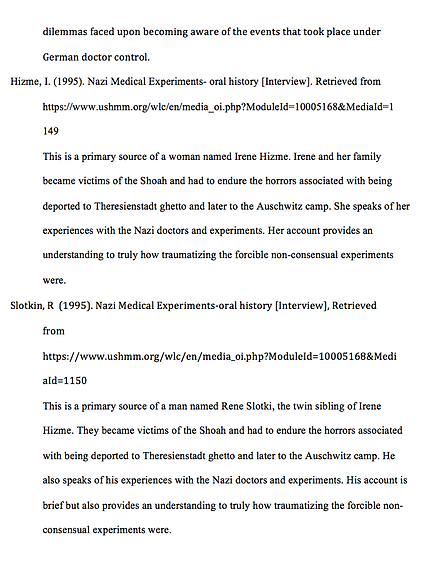
Spring Semester Culminating Research Project HUM 264
Presented by: Veronica Vasconcelos
Email: vvasconcelos13@bristolcc.edu
-
What roles did the German Doctors play in the Shoah, particularly in the medical experiments and euthanasia programs?
-
What factors led to deadly medicine?
-
What are the moral and ethical issues involved?
1933-1945
Intro
As we should already understand, in genocides there are victims, silent bystanders, liberators, and perpetrators. However, one of the many perpetrators involved in the Shoah include the German doctors whom were ironically responsible for the unethical and tortuous deaths of thousands. The purpose of this research is to explore the roles that these doctors played in euthanasia programs and medical experiments. Also, to understand some factors that influenced deadly medicine and understand the moral and ethical issues involved.
Topic Questions
Experiments
Unethical and non consensual deadly experiments were performed on thousands of concentration camp prisoners. Many of the experiments were deliberately designed to terminate in a fatal outcome for their patients. The overall desired outcome for the experiments aimed to find efficient and inexpensive ways to rid racially or genetically undesirable individuals.
-
Hypothermia Experiments- prisoners were immersed into ice water tanks for hours at a time to discover how long German pilots could survive in frozen water when downed by enemies
-
High-altitude Experiments- decompression chambers were used to stimulate high altitude conditions
-
Sea Water Experiments- subjects were given unaltered sea water to determine potability of sea water
-
Sulfanilamide Experiments- war wounds were recreated and deliberately infected on conscious patients in order to evaluate possibilities of new wound treatments for injured soldiers
-
Tuberculosis (TB) Experiments- to determine natural immunities to TB and develop a vaccine against it
The experiments can be divided into 3 categories:
-
Experiments aimed at facilitating the survival of Axis military personnel.
-
Experiments aimed at developing and testing pharmaceuticals and treatment methods for injuries/illnesses acquired through military occupation.
-
Experiments aimed to advance the racial and idealogical tenets of the Nazi worldview. Focused on anthropological, genetic, and racial goals.

-
Poison Experiments- evaluated how fast subjects would die from intravenous injection of phenol gasoline and cyanide
-
Wound Experiments- Rascher tested a newly developed blood coagulate on living conscious patients where they endured fresh amputations of their limbs
-
Artificial Insemination Experiments- victims involved were mostly married women preferably with no children. Victims lived in constant fear of death, sterilization, or insemination.
-
Sterilization Experiments- victims had their genitals mutilated in order to discover cheap methods of sterilization in hopes of applying the findings on millions of unwanted prisoners.
-
Twin Experiments- the outcome goal was to find ways of efficiently and effectively multiply the aryan race.
-
Jewish Skeleton Collection- outcome goal was to acquire large collections of Jewish skulls and bones of victims to create a museum dedicated to the anticipated extinct Jewish race.

Dr. Sigmund Rascher: Responsible for hypothermia, high altitude, poison, and wound coagulate experiments.
The Doctors

Dr. Hans Eppinger: Responsible for the sea water experiments.

Dr. Kurt Heissmeyer: Responsible for TB experiments, especially on children.
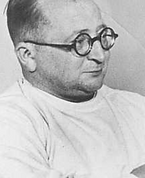
Dr. Carl Clauberg:
Gynecologist responsible for artificial insemination and sterilization experiments.
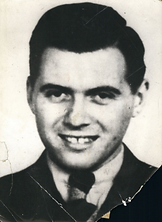
Dr. Josef Mengele:
Responsible for the twin experiments

Dr. August Hirt:
Responsible for Jewish Skeleton Collection
(Alexander, "Medical Science under Dictatorship")
(Cohen, "The Ethics of Using Medical Data From Nazi Experiments")
(Cohen, "The Ethics of Using Medical Data From Nazi Experiments")
(USHMM, "Nazi Medical Experiments")
Irene Hizme
Interview:1995
Describes medical experiments at Auschwitz
Born: 1937, Teplice Sanov, Czechoslovakia

irene

Rene Slotkin
Rene Slotkin
Interview:1995
Describes medical experiments at Auschwitz
Born: 1937, Teplice Sanov, Czechoslovakia
Born twins. Irene and Rene's father was killed in the Aushwitz camp in Dec 1941. Rene, Irene, and their mother were sperated and later subjected to medical experiments. The twins did remain sperated even after liberation. However a group called Rescue Children brought Irene to the US in 1950 where she was reunited with Rene.
"Euthanasia"
"Good Death"
The Germans' ironic use for this term came about as a a result of their method of systematically murdering mentally and physically disabled and debilitated patients occupying institutional settings.
The "euthanasia" program aimed to eliminate individuals considered "life unworthy of life" because they represented a genetic and financial burden on the German society.
Medical personnel were ordered to report newborns and children under the age of 3 with severe disabilities. This decree was issued by the German government on August 18, 1939. Eventually, the age requirement increased to 17 years old to eventually adults. This is now known as operation T4.
Categories of Euthanasia Patients

Adolf Hitler's authorization for the Euthanasia Program dated, Sept 1, 1939. Originally printed in German language. It was first discussed by Nazis in 1933.
This is as pictured in course reading material: War and Genocide, Doris L. Bergen pg.161
(USHMM, "Euthanasia Program")
(USHMM, "Euthanasia Program")

Dr. Karl Brandt:
Head of the medical section of T4 program. The killing arrangements, methods, and training of associated personnel were under his direction.
(Alexander, "Medical Science under Dictatorship")
-
Those who suffered from schizophrenia, epilepsy, dementia, encephalitis, and other chronic psychiatric or neurological disorders
-
Those who were not of German or related blood
-
The criminally insane
-
Those who had been confined to the institution in question for more than 5 years
(USHMM, "Euthanasia Program")

Philipp Bouhler:
SS official. The administrative section of the T4 program

(Alexander, "Medical Science under Dictatorship")
"According to records, 275,000 people were put to death in these killing centers"
List of the T4 Gassing installations
"all state institutions were required to report all patients who has been ill five years or more and who were unable to work, by filling out questionnaires giving name, race, marital status, nationality, next of kin, whether regularly visited and by whom, who bore financial responsibility and so forth"

Sample of questionnaire Printed in German language
Within hours upon arrival from the buses, patients were crowed into gas chambers and cremated shortly afterwards. The ashes of all the victims were collected into large piles and then workers filled some ashes from the pile into urns to send to relatives of the victims.
Sent along with the urns was documentation / a death certificate that doctors and functionaries falsified and created fictive causes of death, often claiming that victims died of natural causes.

Buses used to transport patients to Hadamar euthanasia center had the windows painted to prevent people from seeing those inside
-
Bernburg, in Saxony
-
Brandenburg, on the Havel River near Berlin
-
Grafeneck, in Southwestern Germany
-
Hadamar, in Hessen
-
Harthelm, near Linz on the Danube in Austria
-
Sonnenstein, in Saxony
(USHMM, "Euthanasia Program")
(USHMM, "Euthanasia Program")
Contributing Factors
The Nuremberg Laws
Focused on two distinct factors:
-
Excluding German Jews from Reich citizenship
-
Prohibiting Jews from marrying or having sexual relations with people of German or related blood.
There was no scientific basis to defining or identifying Jews as a race. Genealogy and family tress became the primary basis of their methodology.
(USHMM, "Nuremberg Laws")
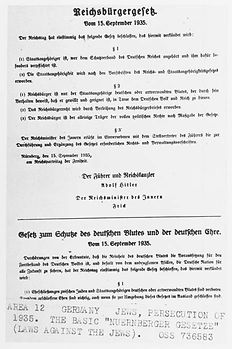
The Reich Citizenship Law and the Law for the Protection of German Blood and Honor. Commonly known as, The Nuremberg Law.
Dated September 15, 1935
Surprising findings
Nazi Germany was not the first to practice human sterilization techniques. The United States was the first when the Supreme Court agreed on ruling the decision of sterilizing individuals deemed mentally defective and institutionalized. This is known as the Buck vs. Bell case of 1927.
(USHMM, "Forced Sterilization")
The Sterilization Laws
The Nazi dictatorship enacted the Law for the Prevention of Genetically Disesead Offspring on July 14, 1933
"The new Nazi law was coauthored by Falk Ruttke, a lawyer, Arthur Gütt, a physician and director of public health affairs, and Ernst Rüdin, a psychiatrist and early leader of the German racial hygiene movement.
Individuals who were subject to the law were those men and women who “suffered” from any of nine conditions assumed to be hereditary: feeblemindedness, schizophrenia, manic-depressive disorder, genetic epilepsy, Huntington’s chorea (a fatal form of dementia), genetic blindness, genetic deafness, severe physical deformity, and chronic alcoholism."
(USHMM, "The Biological State: Nazi Racial Hygiene, 1933-1939")

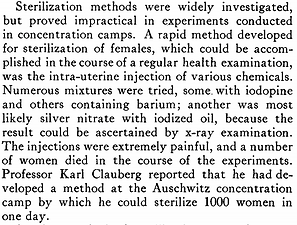
Ethical and Moral Issues Involved


Ellie Weisel, a Nobel Peace Prize winner, a former professor of religion and philosophy at Boston University, and Holocaust survivor.

"Their education provided them with no shield, no shelter from the temptation and seduction of cruelty that people may carry within. Why? This question still haunts me."
"Nazi doctors did their work without any crisis of conscience. They were convinced that by helping Hitler to realize his racial ambitions, they were contributing to the salvation of humanity. "
"I personally met only one: Josef Mengele, who was known best not as a doctor but as a criminal and a murderer. Like so many other deportees, I saw him the night of my arrival in Birkenau. I remember the thought that crossed my mind: he looked elegant. I remember his calm voice as he asked me my occupation and age (warned by an inmate, I made myself older). And I recall his fateful gesture that separated the living from the soon-to-be dead. I learned his name only later. Morbid rumors went around about him. Wherever he sprang up, Death spread its shadow. It was known that he was always on the lookout for little twins and children with spinal problems. In the camp for Gypsies, he came across as likeable, warm, and tender toward one particular boy. He had the boy dressed in nice clothes, gave him the best food. This was his favorite prisoner. And on the night the Gypsies were liquidated, the doctor himself led this boy to the gas chamber."
-
How is it possible that physicians could have been involved in human atrocities of sterilization, euthanasia, murder and genocide?
-
Physicians must swear under the Hippocratic Oath to protect the health and well-being of others.

A translated portion of the Hippocratic Oath states : “I will utterly reject harm and mischief. I will not give anyone deadly poison, even when asked, nor will I be the one to propose such a course of action”
Validity of Experimental Results
(Weisel, "WIthout Conscience")
-
The victims suffered, lacked informed consent, and endured experiments that were designed to end in death. It would be unethical to use the results of these tortuous medical experiments.
-
There's also manipulation of language and removal of commonly accepted definitions in the research which would serve as an attack on the integrity of science.
-
Others may argue that the results should be used as a form of honoring the deaths of the perished victims.
-
However, one must consider the health status of the victims prior to the experiments. Many victims were emaciated. For example, when it comes to the hypothermia experiments, a test subject with very low body fat would lead to unreliable findings.
-
Doctors were integral to the concentration camp system, they carried out their duties as a result of fear, hostility, suspicion, rivalry, and intriguement.
Testimony
(Cohen, "The Ethics of Using Medical Data From Nazi Experiments")
( de Haller, "The Hippocratic Oath in Latin with English Translation")
Annotated Citations

